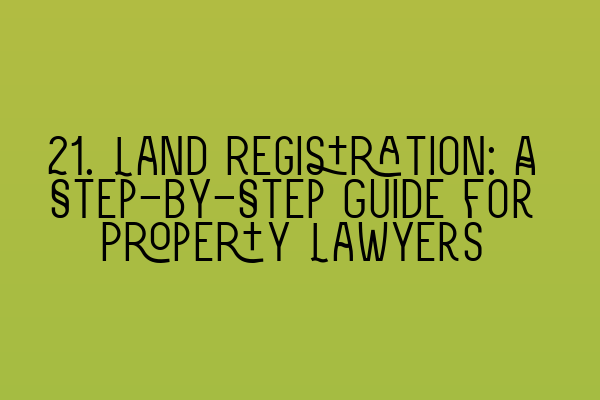21. Land Registration: A Step-by-Step Guide for Property Lawyers
Welcome to SQE Property Law & Land Law’s comprehensive guide on land registration. As property lawyers, understanding the process of land registration is crucial to our practice. This step-by-step guide will walk you through the essential aspects of land registration, helping you navigate the complexities of the system with ease.
What is Land Registration?
Land registration is the process of recording the ownership and interests in land on an official register. In England and Wales, land registration is governed by the Land Registration Act 2002. The benefits of land registration include establishing proof of ownership, facilitating property transactions, and providing an accessible and up-to-date record of ownership and interests in land.
Step 1: Prepare the Application
The first step in land registration is to prepare the application. This involves gathering the necessary information and documents, including the property’s title deeds, any relevant leases, agreements, or restrictions, and details of any mortgages or charges on the property. It is important to ensure that all information provided is accurate and up-to-date.
Pro Tip: Need help with SQE 1 preparation? Check out our SQE 1 Preparation Courses and SQE 1 Practice Mocks FLK1 FLK2 to increase your chances of success!
Step 2: Complete the Application Form
The next step is to complete the application form. The Land Registry provides various forms for different types of applications, such as first registration, transfer of ownership, or registration of leases. It is important to use the correct form and provide all the required information. Any mistakes or omissions may result in delays or rejections of the application.
Step 3: Pay the Fees
Once the application form is complete, the next step is to pay the applicable fees. The Land Registry charges fees based on the type of application and the value of the property. It is important to ensure that the correct fees are paid to avoid any delays in the registration process.
Pro Tip: Looking for practice exam questions? Check out our SQE 1 Practice Exam Questions to test your knowledge and improve your understanding of property law!
Step 4: Submit the Application
After completing the application form and paying the fees, the next step is to submit the application to the Land Registry. This can be done online or by post, depending on the preference and requirements of the Land Registry. It is important to keep a copy of the application and any supporting documents for reference.
Step 5: Application Processing
Once the application is submitted, the Land Registry will process the application. This includes verifying the information provided, conducting necessary searches, and examining the supporting documents. The Land Registry may request further information or clarification if required.
Step 6: Issue of Land Certificate
If the application is accepted and processed successfully, the Land Registry will issue a land certificate. This certificate serves as proof of ownership and contains information about the property, such as boundaries and any registered charges or restrictions. It is important to keep the land certificate safe and secure.
Step 7: Update the Ownership Record
Once the land certificate is issued, the register of ownership will be updated to reflect the new owner’s details. This ensures that the ownership record is accurate and up-to-date. It is important to notify any relevant parties, such as mortgage lenders or tenants, about the change in ownership.
Pro Tip: Need help with SQE 2 preparation? Check out our SQE 2 Preparation Courses to ace your exams and enhance your understanding of property law!
Conclusion
Land registration is a vital process for property lawyers, ensuring clarity and security in property transactions. By following this step-by-step guide, you can navigate the land registration process with confidence and efficiency. Remember to double-check all information, pay the correct fees, and submit a complete and accurate application to avoid any delays or rejections.
For the latest information on SRA SQE exam dates, visit our article on SRA SQE Exam Dates. Good luck with your land registration applications and your future career as a property lawyer!
